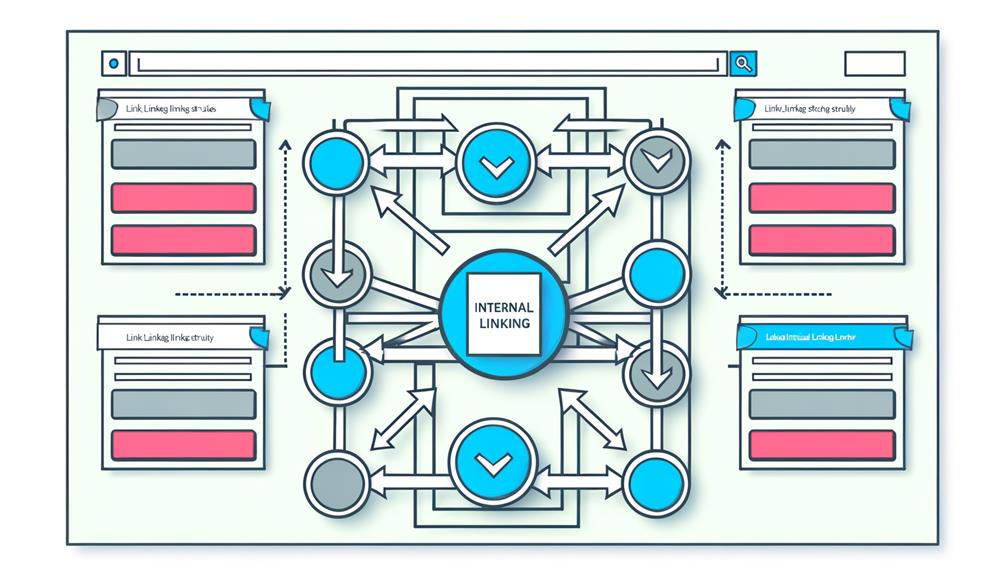We can achieve successful, non-spammy programmatic SEO by leveraging automation to save time and reduce errors. Using templates guarantees consistency across thousands of pages, targeting low-competition keywords to boost search visibility. Focusing on user intent helps us create valuable, relevant content that meets our audience's needs. Avoiding doorway pages and manipulative tactics maintains our practices ethical. Optimizing user experience with fast-loading, responsive pages enhances engagement. Data-driven decisions and regular updates secure sustained performance. Real-world examples show the effectiveness of a user-centric approach. Follow our strategy to master programmatic SEO without the pitfalls of spammy practices.
Key Takeaways
- Utilize automation to efficiently create high-quality, relevant landing pages targeting low-competition keywords.
- Ensure content meets user intent and provides genuine value to avoid manipulative SEO tactics.
- Regularly update and monitor landing pages to maintain quality and relevance over time.
- Implement a logical internal linking structure to enhance user experience and improve search engine discovery.
- Stay updated with algorithm changes and adjust strategies to maintain and enhance search rankings.
Understanding Programmatic SEO
Programmatic SEO automates the creation of keyword-targeted landing pages, enabling brands like Zapier to scale up to 800K pages and greatly boost organic traffic. By leveraging templates, we can generate these keyword-specific landing pages efficiently, catering to the diverse search queries of our target audience. This method allows us to achieve SEO at scale, making it possible to create thousands of automated targeted pages without sacrificing quality.
When we explore programmatic SEO, we see how keyword-specific content plays an essential role. The process begins with identifying the right keywords that our audience is searching for. Once we've our keywords, we can use templates to create multiple landing pages tailored to these queries. This approach isn't only efficient but also guarantees that our content is highly relevant to user searches, improving our chances of ranking higher on search engines.
Brands like Agoda, Bookings.com, and Tripadvisor have successfully utilized programmatic SEO to reach specific audiences efficiently. The scalability in SEO provided by programmatic methods means we can adapt and expand our content strategy rapidly, meeting the ever-changing needs of our audience while maintaining a strong online presence.
Benefits of Programmatic SEO

Let's explore the key benefits of programmatic SEO:
- Scalability and efficiency
- Targeted content generation
- Improved search rankings
By automating repetitive tasks, we can manage large websites and multiple domains more effectively.
Additionally, programmatic SEO helps us create precise, data-driven content that boosts our search engine performance.
Scalability and Efficiency
By automating the creation of thousands of landing pages targeting low-competition keywords, we achieve unparalleled scalability and efficiency in our SEO strategy. Programmatic SEO allows us to save considerable time by automating repetitive tasks like keyword research and content optimization. This efficiency means we can focus our efforts on more strategic initiatives, guaranteeing every action we take adds value.
The use of templates in programmatic SEO is a game-changer, enabling quick and uniform implementation. Templates allow us to efficiently target entire keyword categories, greatly boosting our search visibility. This automation not only enhances our productivity but also ensures that our SEO efforts are both extensive and precise.
Here's a quick breakdown of the benefits:
| Benefit | Impact |
|---|---|
| Automation | Saves time and reduces manual errors |
| Templates | Guarantees consistency across landing pages |
| Targeting Keyword Categories | Boosts search visibility |
| Scalability | Enables creation of thousands of pages |
With programmatic SEO, we're not just increasing the quantity of our content but also its quality and relevance. By targeting ready-to-buy audiences effectively, we can generate more backlinks and achieve higher search rankings. This strategy helps us build a stronger online presence and fosters a sense of community among our audience, who feel catered to and understood.
Targeted Content Generation
How can we effectively generate targeted content that boosts our search visibility and captures niche audiences? By leveraging programmatic SEO, we can automate the creation of landing pages that are precisely tailored to specific keywords. This method enhances our ability to target low-competition keywords, thereby increasing our chances of ranking higher in search results.
Programmatic SEO allows us to efficiently generate multiple landing pages through templates and automation, ensuring each page contains relevant, user-centric content. This approach not only saves time but also helps us reach specific audiences searching for niche or long-tail keywords.
Here are three key benefits of targeted content generation through programmatic SEO:
- Scalability: By automating the creation of landing pages, we can scale our content production efforts without compromising quality. This scalability is important for targeting a wide range of low-competition keywords.
- Improved Keyword Targeting: Each landing page can be optimized for a unique keyword, enhancing our keyword targeting strategy and ensuring we capture diverse search queries.
- Enhanced User Experience: Personalized content tailored to specific keywords improves user experience, making visitors feel understood and valued, which can lead to higher engagement and conversions.
Improved Search Rankings
Harnessing the power of programmatic SEO, we can greatly enhance our search rankings by efficiently targeting low-competition keywords and scaling our content efforts. By leveraging automation, we create numerous landing page templates tailored to specific search queries. This approach not only boosts our search visibility but also guarantees a user-friendly experience, steering clear of spammy practices.
Our data-driven decision-making process is the backbone of successful programmatic SEO. We analyze vast amounts of search data to identify the most promising low-competition keywords. This precision targeting allows us to climb search rankings more effectively, driving organic traffic to our site.
The automation aspect of programmatic SEO ensures we can scale our efforts without compromising quality, creating a multitude of unique landing pages that cater to various user intents.
Successful programmatic SEO campaigns are characterized by their ability to generate substantial organic traffic. As our search rankings improve, we also become a more attractive target for potential backlinks, further solidifying our online presence. By focusing on data and user experience, we foster a sense of belonging among our audience, delivering content that meets their needs while enhancing our search engine performance.
Keyword Research Techniques

Let's start by identifying niche opportunities using tools like SEMrush and Ahrefs to find low-competition keywords.
We'll analyze competitor keywords to understand what's working in our industry and leverage long-tail keywords to target specific user intents.
Identify Niche Opportunities
To identify niche opportunities, we'll dive deep into keyword research using tools like SEMrush, Ahrefs, and Google Keyword Planner to uncover low-competition, high-search-volume keywords that match user intent. Our goal is to find those golden long-tail keywords that not only align with our niche but also have low keyword difficulty scores. This strategic approach is important for effective programmatic SEO.
Here's how we can get started:
- Utilize Keyword Research Tools: By leveraging SEMrush, Ahrefs, and Google Keyword Planner, we can gather extensive data on search volumes, keyword difficulty, and user intent. These tools help us pinpoint low-competition niches where we can thrive.
- Focus on User Intent: Understanding what our audience is searching for allows us to select keywords that meet their specific needs or queries. This user-centric approach ensures that our content is valuable and relevant, enhancing our programmatic SEO efforts.
- Identify Long-Tail Keywords: Long-tail keywords often have lower competition but high search volume. These keywords are more specific and can attract a targeted audience, making them ideal for niche opportunities.
Analyze Competitor Keywords
By scrutinizing competitor keywords with tools like SEMrush and Ahrefs, we can uncover gaps and opportunities to enhance our programmatic SEO strategy. These tools help us identify competitor keywords and their search volumes, giving us a clear picture of what's working for others in our industry.
This data-driven approach allows us to pinpoint long-tail keywords and low-competition keywords that are often overlooked but can drive targeted traffic.
Understanding the intent behind keywords is essential. Are users looking for information, making a purchase, or seeking a service? By grasping this intent, we can tailor our content and calls-to-action to meet their needs effectively. This user-centric strategy ensures we're not only attracting visitors but also engaging and converting them.
Regularly updating our keyword research is vital for staying ahead. Industry trends and competitor movements can shift, and what works today mightn't be as effective tomorrow. By keeping a pulse on these changes, we can adapt our strategies to maintain a competitive edge.
Ultimately, aligning our keyword research with current industry trends and competitor insights helps us create a robust, non-spammy programmatic SEO strategy that resonates with our audience.
Leverage Long-Tail Keywords
Building on our understanding of competitor keywords, we can now leverage long-tail keywords to capture highly targeted traffic with lower competition and higher conversion rates. These keywords are invaluable for programmatic SEO because they account for 70% of all search traffic. By focusing on long-tail keywords, we can create optimized landing pages that cater to specific search intent and drive better engagement.
To effectively harness the power of long-tail keywords, we need to conduct thorough keyword research.
Here are three key steps to get us started:
- Utilize Keyword Research Tools: Platforms like SEMrush, Ahrefs, and Google Keyword Planner are essential for discovering profitable keywords. These tools help us identify terms that are both relevant to our niche and have high conversion potential.
- Analyze Search Intent: Understanding what users are looking for when they enter long-tail keywords is important. This allows us to tailor our content and landing pages to meet their needs, resulting in higher conversion rates.
- Focus on Specificity: Long-tail keywords often reflect higher intent. By targeting these specific terms, we can attract users who are more likely to engage deeply with our content and convert.
Creating Valuable Content

Crafting unique and valuable content for each landing page is crucial to meeting the search intent of targeted keywords and enhancing user experience. When we create high-quality, informative content that aligns with the specific search queries our audience uses, we not only address their immediate needs but also build trust and credibility.
Each landing page needs to be rich in relevance, offering clear, concise, and actionable information.
To achieve this, we focus on understanding the search intent behind each keyword. Are users looking for detailed guides, product comparisons, or quick tips? By tailoring our content to these needs, we guarantee that our landing pages aren't only engaging but also effective in driving conversions. Including relevant images, headings, and metadata can further enhance the user experience.
Moreover, we must regularly monitor and update our programmatic landing pages to maintain their relevance and quality over time. This iterative approach ensures that our content remains valuable and up-to-date, keeping users engaged and satisfied.
Avoiding Doorway Pages

We need to steer clear of creating doorway pages, making sure our landing pages always offer genuine value to users and align with search engine guidelines. Doorway pages are low-quality web pages that exist solely to manipulate search engine rankings. Not only do they fail to provide valuable content, but they also risk penalization by search engines like Google.
To avoid these pitfalls and succeed with programmatic SEO, we should focus on the following strategies:
- Create Valuable Content:
Our landing pages must deliver high-quality content that meets user search intent. This means understanding what users are looking for and providing detailed, relevant information.
- Follow Search Engine Guidelines:
Adhering to search engine guidelines is critical. We should regularly review and update our landing pages to ensure compliance and maintain high rankings.
- Leverage Programmatic SEO:
Use programmatic SEO to generate landing pages that are rich in valuable content and tailored to specific search queries. This allows us to scale our efforts while still focusing on quality.
Optimizing User Experience

Optimizing user experience on our landing pages is essential for achieving higher engagement and conversion rates. By focusing on several critical factors, we can create a seamless and enjoyable experience for our users. First and foremost, we must guarantee our landing pages load in under 2 seconds. Fast-loading pages greatly enhance user experience and reduce bounce rates.
Responsive design is another pivotal element. Catering to users on different devices, such as mobile and desktop, ensures a consistent and pleasant experience. We can't overlook the importance of clear CTAs. Concise and compelling calls-to-action guide users towards desired actions, leading to higher conversion rates.
Creating unique content that addresses user search intent is indispensable. High-quality, valuable content keeps users engaged and encourages them to stay longer on our pages. Regularly testing and optimizing pages for usability, readability, and visual appeal is crucial to maintaining a positive user experience.
| Key Factor | Description |
|---|---|
| Page Load Time | Guarantee loading under 2 seconds |
| Responsive Design | Cater to mobile and desktop users |
| Clear CTAs | Implement concise calls-to-action for higher conversion rates |
| Unique Content | Create valuable content that meets user search intent |
| Regular Optimization | Test and improve usability, readability, and visual appeal regularly |
Effective Internal Linking

Effective internal linking plays a pivotal role in establishing content hierarchy, enhancing user navigation, and boosting SEO performance. By strategically placing internal links, we can help search engines discover and index new content more efficiently, while also improving the user experience by guiding visitors to relevant pages and reducing bounce rates.
Here's how we can optimize our internal linking strategy:
- Establish a Hierarchy of Importance: Organize our content so that key pages are more prominently linked. This helps search engines understand which pages are most important and deserve higher rankings. By doing so, we distribute link equity effectively and guarantee our top pages receive maximum visibility.
- Use Descriptive Anchor Text: Make sure that the anchor text for internal links is descriptive and contextually relevant. This not only provides clarity to users but also helps search engines better understand the content of the linked pages, contributing to improved rankings.
- Create a Logical Linking Structure: Implement a logical and intuitive linking structure that mimics the way users naturally navigate our site. This enhances the user experience, reduces bounce rates, and ensures that link equity is evenly distributed across our content.
Monitoring and Maintenance

Consistently monitoring and maintaining our programmatic SEO landing pages is essential to guarantee they remain optimized and relevant in the ever-evolving digital landscape. By regularly updating content, checking for broken links, and improving user experience, we make certain that our efforts in programmatic SEO yield sustained results.
Analyzing performance metrics is a core aspect of this process. Metrics such as organic traffic, conversion rates, and bounce rates provide valuable insights into the effectiveness of our SEO strategies. When we identify areas for improvement, we can make data-driven adjustments to enhance our campaigns.
| Task | Frequency |
|---|---|
| Content Updates | Monthly |
| Broken Link Checks | Weekly |
| Performance Metrics Review | Bi-Weekly |
Additionally, staying vigilant about algorithm updates is essential. Search engines frequently change their algorithms, which can impact our rankings. By monitoring these updates, we can swiftly adjust our strategies to prevent penalties and maintain our search rankings.
Continuous maintenance of our landing pages is not just about keeping up with algorithm changes; it's about adapting to evolving user behavior and search engine trends. This ongoing optimization ensures that we provide the best possible user experience, keeping our audience engaged and our SEO efforts effective. Together, we can navigate the complexities of programmatic SEO and achieve lasting success.
Real-World Success Stories

Several companies have demonstrated the power of programmatic SEO by achieving remarkable rankings and driving substantial organic traffic through targeted, automated content strategies. Let's explore some real-world success stories that highlight the potential of a well-executed SEO process.
- Expedia: By effectively utilizing programmatic SEO, Expedia has created thousands of programmatic landing pages targeting various travel destinations. This strategy has allowed them to rank for a wide range of travel-related keywords, driving enormous organic traffic.
- Canva, Zapier, and Eater: These companies have successfully implemented programmatic SEO strategies to rank for numerous relevant keywords. By focusing on creating landing pages that address user needs, they've managed to capture significant search visibility and user engagement.
- Agoda, Bookings.com, and Tripadvisor: These travel giants leverage programmatic landing pages to reach their target audiences effectively. By automating the creation of keyword-targeted web pages, they've achieved impressive rankings and substantial organic traffic.
On 'Crawling Mondays by Aleyda,' we've seen frequent discussions around these examples of successful programmatic SEO implementations. These case studies underline the importance of a user-centric approach in the SEO process.
It's clear that with the right strategy, programmatic SEO can yield non-spammy, high-quality results that resonate with users and search engines alike.
Frequently Asked Questions
What Are the Best Practices for Programmatic Seo?
We prioritize content quality, employ a strategic keyword strategy, and leverage automated tools. Data analysis and understanding user intent guide our approach. Competitive research and backlink building further enhance our programmatic SEO efforts, ensuring we achieve success together.
Does Programmatic SEO Still Work?
Remember the tale of David and Goliath? Yes, programmatic SEO still works. Despite algorithm changes and evolving user behavior, focusing on content quality, keyword intent, link building, mobile optimization, and search trends keeps us competitive.
How to Execute Programmatic Seo?
To execute programmatic SEO, we start with template creation and keyword clustering. Automated content and data structuring help streamline processes. We use API integration for dynamic updates, competitive analysis for insights, and SERP monitoring for adjustments.
What Is a Programmatic Seo?
Programmatic SEO involves using automation tools and content templates to create keyword-optimized landing pages. We leverage data sources and keyword research to align with user intent, monitor SEO metrics, and adapt to evolving search algorithms.
Conclusion
In the grand tapestry of digital marketing, mastering programmatic SEO can feel like wielding a magic wand. By focusing on robust keyword research, creating valuable content, and optimizing user experience, we can elevate our strategy beyond ordinary.
Let's not forget effective internal linking and diligent monitoring. When we mix these elements, we don't just improve rankings—we achieve SEO wizardry.
Together, let's craft a data-driven, user-centric approach that virtually guarantees success.
